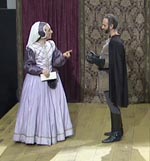- Edition: King Leir
King Leir
- Introduction
- Texts of this edition
- Contextual materials
- Facsimiles
114King Leir, Scene 17
Cast Messenger: Alon Nashman Ragan: Derek Genova
Queen's Men Dramaturgy: Rhetoric (Sc. 17)
115The style of this scene, unlike the formal rhetoric of the majority of the play, creates an illusion of everyday conversation. The deal between the queen and the messenger turns on a single word "Ay" rather than through the kind of heavily patterned exchanges that characterize much of the play. The short dialogue communicating the queen's murderous intention is sparse and to the point and gives the scene a conversational tone. But on careful inspection the scene is as carefully structured as the rest of the play. The exchange comes to a neat rhetorical close when the queen hands the Messenger two purses for the two hands he promises to use to murder Leir and Perillus (TLN 1324-25). The stage image supports the language perfectly, focusing attention on the corrupting influence of money.
Watch video of Scene 17 on the Performing the Queen's Men website. (The video footage is password protected. Click on "Cancel" in the pop-up window to obtain password.)
The Queen's Men Dramaturgy: Narrative Over-Determination (Sc. 17)
116Read about narrative over-determination in scene 14
Ragan warns the Messenger that the king and Perillus will "speak fair" (TLN 1346), but the Messenger assures her that the sound of the gold in his bags will far outweigh the power of their words. The play here sets up the conflict that is at the heart of the spectacular Scene 19, where the Messenger clown becomes the subject of his own moral struggle. In comparison to dramaturgy elsewhere in the play the foreshadowing here is relatively subtle: it raises expectations for conflict without spelling-out the outcome in advance.
Read about narrative over-determination in later scenes.
Performing the Messenger (Sc. 17)
117Read about performing the Messenger in Scene 15
The Messenger's manipulative tactics in this scene also give more weight to Alon Nashman's interpretation of his character as a courtly and sophisticated manipulator rather than the coarse clown I imagined. This scene also lacks the unequivocally comic asides of the Messenger's other scenes and the Messenger's idiom, although direct, remains courtly throughout, lacking the colloquialisms he uses elsewhere in the play. The language of the scene supports Alon's interpretation of the character as a sophisticated, courtly manipulator. Alon still managed a balance between the two interpretations, here giving more weight to the seductive, courtly sophisticate, but still presenting his greed for money as an object of fun.
The Messenger's unrestrained pursuit of financial gain has earned him friends and favour at court, and it here prompts him to murder. Within the feudal world of the Queen's Men's romance, money is at times represented as a destabilizing force and a threat to social order. The Messenger's greed here inspires the promise of excessive violence: "I could tear ten in pieces with my teeth" (TLN 1329). This moment could conceivably be played for horrific effect in an attempt to make an audience fear the consequences of unrestrained greed but we made the political point through mockery rather than through fear by emphasizing the character's clownishness. There was no real sense that Alon would really "tear" anybody or any thing in "pieces."
Read about performing the Messenger in later scenes
Watch video of Scene 17 on the Performing the Queen's Men website. (The video footage is password protected. Click on "Cancel" in the pop-up window to obtain password.)
Performing Ragan (Sc. 17)
118Read about performing Ragan in scene 15
This scene demanded another performance of mock-innocence from Genova (Ragan) as his character pretends that she is too modest to specify her criminal intention. She uses the same tactic to deceive her husband in (Scene 22). Since the audience already knows of her intention, the queen's manipulation is clear to them and adds a level of amusement despite the cruelty of her actions.



